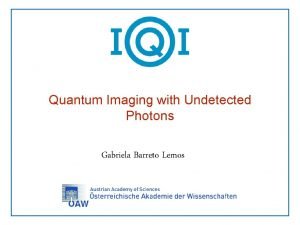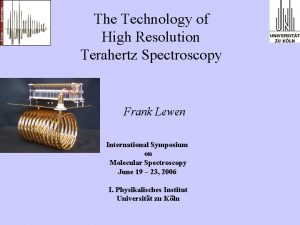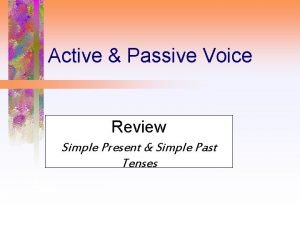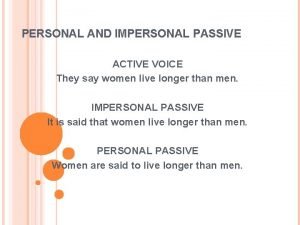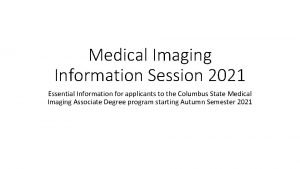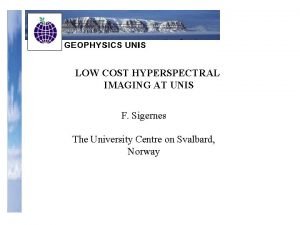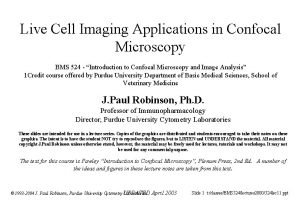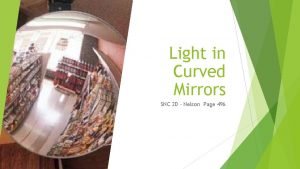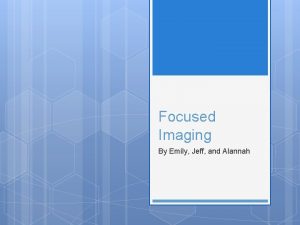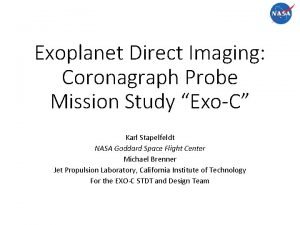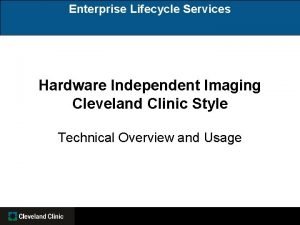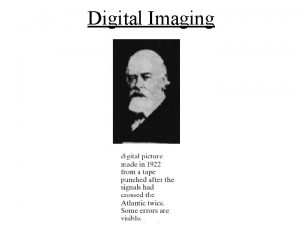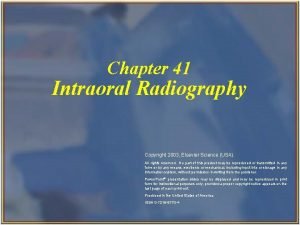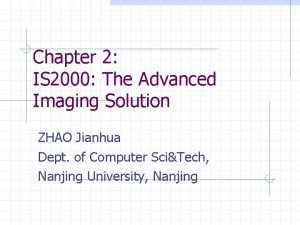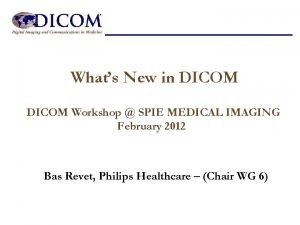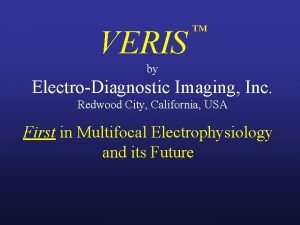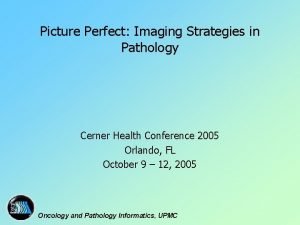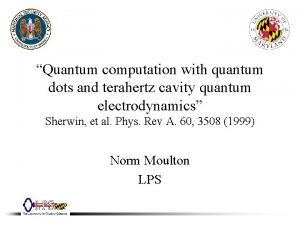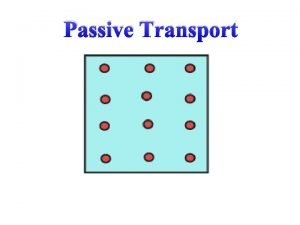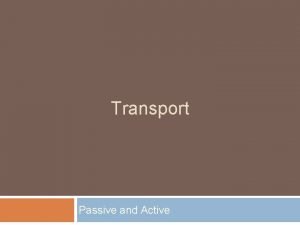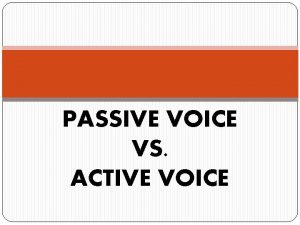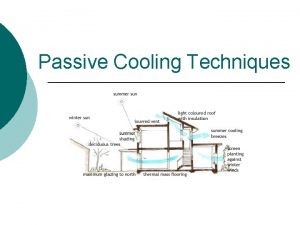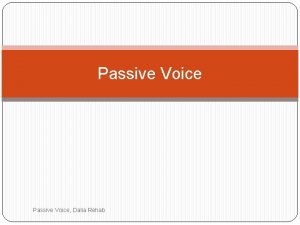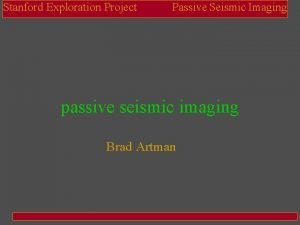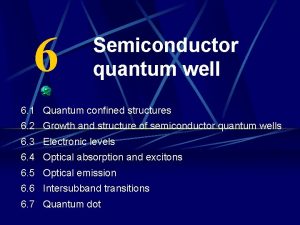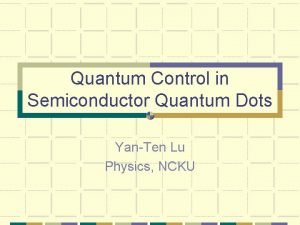Towards passive terahertz imaging using a semiconductor quantum



























- Slides: 27

Towards passive terahertz imaging using a semiconductor quantum dot sensor Vladimir Antonov Royal Holloway University of London http: //www. teraeye. com

Acknowledgments Royal Holloway, UK : H Hashiba Tokyo University&JST, Japan: Prof. S Komiyama, Drs. J Chen, O Astafiev (NEC) ISSP RAN, Russia: Dr. L Kulik NPL, UK: Dr A Tzalenchuk, Dr S Gibling and P Kleinschmidt Chalmers University, Sweden: Prof. P Delsing, Dr S Kubatkin Optisense LTD: M Andreo

Passive Imaging with superconducting bolometer by VTT-NIST Nb superconducting bolometer Detection of hidden weapon Courtesy of VTT-NIST

Some numbers for consideration Noise Equivalent Temperature Difference (NETD) imposed by the temperature contrast, or variation of spectral intensity (spectral fingertips) < 0. 1 K Background limited noise BLIP~ T(F/n)1/2 , where F - frame rate (10 Hz), n - number of detected photons (108), ~0. 05 K Detector should have NETD better than 0. 1 K and counting rate around 108 photons/sec

Some numbers for consideration Passive imaging T=305 K T=300 K U, 10 -21 J /(Hz m 3) U, 10 -19 J /(Hz m 3) Plank’s law f , THz There is a difference in ~1010 photons/sec (~10 -23 J) for black body radiation at 300 K and 305 K in bandwidth from 0. 5 to 0. 7 THz.

Finger prints of explosives Complex materials has a unique fingerprints in spectrum T=300 K JF Federici et all ’ 05

QD as a spectral sensitive detector Layout of the QD in 2 DEG SEM images of the QD Resonance curve Frequency (/cm) Plasma resonance in QD 60 Zero filed 40 0 c 20 0 APL ’ 02 QD in magnetic field 0 1 B 2 (Tesla) 3 4 5

QD-SET detector Log-periodic circular antenna (0. 2 -3 Thz) coupled with QD sensor Energy diagram Dark switches and photo-response SET response to QD excitation DVg original peaks shifted peaks

Modeling of QD-SET SG 1 Offset charge at SET QD NSET+1 QSET SG 2 CG -Vc

Formation of QD 2 D map of SET current Individual SET trace Charging of the QD

Photosignal at 0. 3 K T=0. 05 K T=0. 3 K

Photo response and dark counts Noise Equivalent Power~ 10 -20 Watt/Hz 1/2 NETD = NEP/(2 hk. BDnt 1/2) ~0. 01 K Quantum Efficiency ~1% Spectral bandwidth ~ 1% Operation temperature is limited by SET (up to 4 K) APL, JAP, PRB, IEEE ’ 04 -07

Photosignal at 0. 5 -0. 7 K

2 D maps of QD-SET Emitter is OFF V S, V Emitter is ON V C, V Physica E ’ 06 PRB’ 06

Detector of different designs A lateral sensor with QD crossing the channel A lateral sensor with QD inside channel A lateral sensor with QD outside channel A vertical sensor

QD outside of 2 DEG channel QD-SET Gate

QD inside the 2 DEG channel

QD in high magnetic field SEM picture of the QD 1 m LL 1 LL 0 NATURE, 2000

QD in high B QD under illumination Spectral sensitivity of the detector Time traces of QD conductance

QD in high B Lifetime of excitations QD has three levels: LL 1 I PRB, 2002 LL 0 , LL 0¯, II

LT THZ microscope of Tokyo University Ikushima, Komiyama APL, 2006

LT THZ microscope of Tokyo University

Future plans: Quantum Dot in DQW heterostructure Schematic view Inter-well excitation in asymmetric DQW ~1 THz

Near-field antennae Near-field antenna Simulation of near-field antennae 50 m Simulation of E-field

Near-field antenna

Challenges QD detector: which type? Room Temperature Imaging Source of THz radiation for in-situ calibration • Physics of isolated QD in DW heterostructures

Vertical sensor in DQW heterostructure An et all, PRB’ 07
 Frc control system
Frc control system Quantum imaging with undetected photons
Quantum imaging with undetected photons High-resolution terahertz
High-resolution terahertz Terahertz spectroscopy principles and applications
Terahertz spectroscopy principles and applications Classical physics
Classical physics Quantum physics vs quantum mechanics
Quantum physics vs quantum mechanics Passive voice in present perfect continuous tense
Passive voice in present perfect continuous tense Simple past active and passive voice
Simple past active and passive voice Personal impersonal passive
Personal impersonal passive Present progressive passive examples
Present progressive passive examples To eat au present simple
To eat au present simple Windows imaging acquisition
Windows imaging acquisition Ohiohealth berger hospital mammography circleville
Ohiohealth berger hospital mammography circleville Affordable hyperspectral imaging
Affordable hyperspectral imaging Live cell imaging ppt
Live cell imaging ppt Salt reflection acronym
Salt reflection acronym Focused imaging learning
Focused imaging learning Direct imaging subsystem
Direct imaging subsystem Hardware independent imaging
Hardware independent imaging Digital imagery definition
Digital imagery definition Digital imaging artist
Digital imaging artist Implementation support
Implementation support Too little vertical angulation results in images that are
Too little vertical angulation results in images that are Is2000 the advanced imaging solution
Is2000 the advanced imaging solution Spie
Spie Imaging near redwood city
Imaging near redwood city Picture perfect imaging
Picture perfect imaging Nuclear imaging techniques
Nuclear imaging techniques

